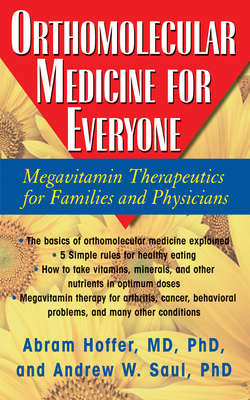Читать книгу Orthomolecular Medicine for Everyone - Abram Hoffer M.D. Ph.D. - Страница 10
THE PRINCIPLE OF INDIVIDUALITY
ОглавлениеEvery division of medicine is bolstered by a set of principles based upon theoretical ideas and practical experience in dealing with patients. One of these principles in orthomolecular medicine is individuality—the fact that every person is unique and has different nutrient requirements and responds differently to treatment. Knowledge of individuality is ubiquitous from the time an infant first recognizes its mother as different from other women. The facts of physical and anatomical differences are not in dispute. We each have a particular shape, form, color, personality, and life history. The use of names recognizes that fact and the importance of individuality.
Physicians are equally aware of anatomical individuality but are less aware that there are wide ranges of need for drugs and even more variation in optimum vitamin requirements. Surgeons hope that an appendix that must be removed is where it is supposed to be, but good surgeons are not surprised when it is not. Physicians know a few patients are eased of their depression with 25 milligrams (mg) of a standard antidepressant, while some require 10 times as much. Nutritionists know nutrient requirements vary and that each person has a unique need for proteins, fats, carbohydrates, and micronutrients, but nearly every non-orthomolecular professional grossly underestimates the wide range of variation. Roger Williams was one of the pioneer researchers in this area, providing a persuasive summary of the vast data for the biochemical uniqueness of people in 1956.2
When any population is examined for any one attribute, such as height, weight, shape, or color, there is a range in the measurements. Height varies from under two feet in infants to over seven in a few adults. Most male adults range between four-and-a-half and six feet tall. When height is plotted against the number of people at that height, one has drawn a frequency distribution curve. Many more men will have a height of five-and-a-half feet than five or six feet. To give someone a simple estimate of the height of the population, we would estimate the average height and also the degree of deviation from it by the standard deviation. This statistic has been so arranged that the mean value plus or minus two standard deviations from this mean will account for about 95 percent of the population. About 5 percent of any group will vary beyond this range for biological variables in general.
Normally, the curve looks like a bell. The bell-shaped distribution curve applies to other measures, such as daily need for protein and for vitamins or minerals, but for each nutrient the curve will have a different shape. It may be short and broad or narrow, or it may not be bell-shaped. But for each one, at least 2.5 percent will require more than the rest of the population (the 97.5 percent). We can only surmise why this is the case, as there has been little interest in this phenomenon. In regard to nutrients, there may be a problem with absorption in the intestine. Thus, with pernicious anemia, specific areas in the gut that normally absorb vitamin B12 are lacking, or after the vitamin is absorbed it may not be combined efficiently into its coenzyme, or it may be wasted or held too tenaciously by some organ systems, thus depriving other parts of the body.
Orthomolecular physicians deal with patients whose needs for nutrients lie beyond the usual distribution. These patients require up to a thousand times as much of certain nutrients. For practicing with this principle, orthomolecular physicians are subjected to criticism by physicians who are not aware of these matters and who refuse to believe that a number of chronic diseases are present because these extraordinary nutrient needs are not met.
Because the concept of individuality is so basic to this entire work, it is necessary to enlarge our understanding of its enormous role in all human affairs. I assume that few will disagree with the fact that we differ in visible attributes such as height, weight, color, configuration, fingerprints, and so on. We also differ in physical capability, strength, dexterity, coordination, and skill, and in our interests. Discoverers want to be first, for only one can be so unique; scientists fight over priority, for only the first is remembered and honored. Artists strive to be different, to be known for the uniqueness of their creativity and talent. Uniqueness is often honored and rewarded, but of course it must be the type of uniqueness that society finds acceptable. Some forms of uniqueness lead to imprisonment or involuntary admission to mental hospitals. What few people recognize is that physical, physiological and even psychological factors that are measured as different arise from a metabolic apparatus, our bodies, which are unique. The total of these hidden biochemical factors that create our individuality is much greater than are the visible attributes. Identical twins, who are as alike genetically as it is possible to be, possess many biochemical and nutritional differences. When that one fertilized egg makes an error and divides in two, each of which creates a new individual, there is no perfect division of all the genes or other cellular particles that control life.
